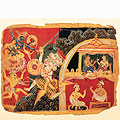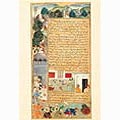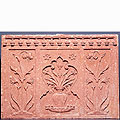 |
|
 |
 |
 |
 |
 |
 |
 |
 |
Art for the Mughal and Rajput Courts
From 1526 through the mid-19th century, much of northern India was ruled by the Mughals, an Islamic dynasty with Central Asian origins. However, some regions of the northwestern part of the subcontinent were under the control of the native Hindu Rajput kings. Much of the history and thus the art history of the era concerns the many and varied ways in which the relationships between the Mughal and Rajput rulers were established and redefined. The art of painting developed greatly under the patronage of both the Mughals and Rajputs. However, only a small number of artists are known as most worked anonymously in ateliers -- the four examples in the Asia Society's collection are not signed. Although primarily supported by royalty and by wealthy merchant communities, artists were not always permanently attached to particular workshop, often migrating between states and patrons. As a result, the Mughal and Rajput styles often influenced each other, especially as artists were not limited by either their religious affiliations or by that of their patron. Other forms of art that flourished at the courts included stone carving, metal-working, and textile and carpet production. The Asia Society's collection contains two intricately carved sandstone screens, typical examples of decorative Mughal stonework. |
 |
 |
| 1 thru 6 of 6 |
 |
| view text only list |
 |

Bhagavata Purana folio |
 |

Ta'rikh-i Alfi folio |
 |

Ragamala folio |
 |

Amaru Shataka folio |
 |

Sandstone Screen |
 |

Sandstone Screen |
 |
|
 |